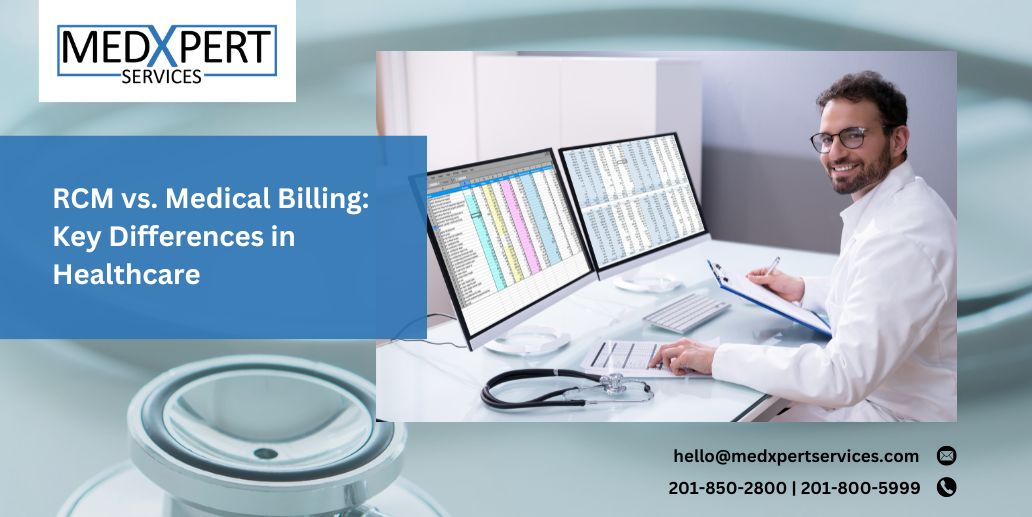Revenue Cycle Management (RCM) and Medical Billing are essential yet distinct elements of healthcare finance management. RCM involves managing the entire lifecycle of patient accounts from initial contact to final payment, integrating several administrative and clinical functions. Medical billing, a critical subset of RCM, focuses more narrowly on processing claims and ensuring timely reimbursements from insurance providers.
While RCM provides a comprehensive overview of financial health, handling everything from patient eligibility to payment collection, medical billing zeroes in on the specifics of claims and codes. This specialization is crucial for maximizing revenue through accurate claim submissions and reducing the likelihood of denials. Both roles are integral to the financial viability of healthcare practices.
In this blog, we will explore how both medical billing and RCM contribute to effective financial management in healthcare, each playing a pivotal but distinct role in the process.
What Is Medical Billing and Revenue Cycle Management?
Medical Billing and Revenue Cycle Management (RCM) are fundamental components of healthcare administration, yet they serve distinctly different roles. While both processes are integral to the financial viability of healthcare services, understanding their unique functions can help demystify the complexities of healthcare financial management.
What is Medical Billing?
Medical billing is a critical subset of the revenue cycle management process, focusing specifically on the submission and processing of claims to insurance companies and patients. This step is crucial for ensuring that healthcare providers receive compensation for their services. Medical billing tasks include:
- Accurate coding of procedures and diagnoses
- Generating and submitting claims according to insurance regulations
- Ensuring timely follow-up on unpaid claims
Medical billing professionals play a vital role in healthcare operations by managing detailed patient data and claim statuses to prevent delays in reimbursement and address any discrepancies in payment.
What is Revenue Cycle Management (RCM) in Healthcare?
What is Revenue Cycle Management (RCM) in Healthcare? RCM represents a comprehensive approach to managing the financial processes that support a healthcare organization. It extends beyond medical billing to include:
- Patient scheduling and registration
- Insurance eligibility and coverage verification
- Charge capture and claims management
- Payment collection and revenue analysis
An RCM system for healthcare organizations is designed to streamline these processes, ensuring efficiency and maximizing revenue. By integrating various administrative and clinical functions, RCM provides a holistic view of the financial health of a healthcare provider, from the first patient interaction to the final payment.
Similarities and Differences Between Medical Billing and RCM
Medical billing and revenue cycle management (RCM) are essential components of healthcare financial operations, each playing a distinct role but ultimately working together to ensure efficient revenue generation.
While medical billing focuses on the processing of claims and reimbursement, RCM encompasses a broader spectrum, integrating various functions to manage the entire revenue lifecycle.
Similarities in Medical Billing and RCM
Medical billing and RCM both aim to improve financial outcomes by ensuring accurate claims processing and timely reimbursements. Their interdependence helps maintain a smooth revenue cycle and effective financial management.
| Aspect | Medical Billing | Revenue Cycle Management (RCM) |
| Focus | Claim processing and reimbursement | Comprehensive financial management |
| Scope | Primarily billing and coding | Involves patient registration to financial reporting |
| Patient Interaction | Limited | High focus on patient experience |
| Data Analytics | Operational insights | Strategic and performance-driven |
| Integration | Often operates independently | Requires cross-department collaboration |
While both systems aim to streamline financial processes, they differ in scope and integration levels, with RCM taking a more holistic approach.
Differences in Medical Billing and RCM
Medical billing focuses on the short-term processing of claims, while RCM encompasses a broader, long-term view of financial management. RCM integrates various departments and processes to optimize the entire revenue cycle.
| Aspect | Medical Billing | Revenue Cycle Management (RCM) |
| Operational Timeframe | Short-term, claim-specific | Long-term, encompassing full patient journey |
| Department Integration | Limited collaboration with other departments | Extensive cross-departmental integration |
| Approach | Transactional | Holistic, patient-centric |
| Emphasis | Speed and accuracy of claims | Revenue optimization and patient satisfaction |
| Data Usage | Focus on immediate claim issues | Advanced analytics for strategic decisions |
The primary distinction lies in their scope; medical billing is a critical component of RCM, but RCM extends beyond billing to encompass broader financial strategies and patient engagement efforts.
Benefits of Revenue Cycle Management in Healthcare
Integrating RCM into healthcare organizations is vital for financial stability and operational efficiency. The importance of revenue cycle management lies in its proactive approach to reimbursement, enhancing visibility into accounts receivable. This not only maintains a healthy revenue stream but also supports strategic decision-making and organizational growth.
Benefits of Revenue Cycle Management in Healthcare:
- Increased Efficiency: Automates billing processes, reducing errors and speeding up claim submissions.
- Improved Cash Flow: Ensures timely reimbursements by addressing payment delays and denials.
- Enhanced Patient Experience: Offers clear communication about billing, improving satisfaction.
- Better Decision-Making: Provides insights into financial performance to identify improvement areas.
- Reduced Administrative Burden: Automates repetitive tasks, easing the workload on staff.
Integrating RCM into your organization ensures clean claims and prompt payments for every patient encounter. By proactively managing reimbursement processes, RCM helps avoid delays and disruptions from denied or underpaid claims, while providing greater visibility into accounts receivable for quicker issue resolution.
What is The RCM Process in Healthcare?
The RCM process in healthcare manages the financial journey from patient registration to payment collection, ensuring accurate and timely reimbursements. The RCM process cycle in medical billing is essential for maintaining a steady revenue stream and minimizing financial disruptions.
Key Steps in the RCM Process
- Patient Registration: Gathers complete and correct patient data upfront to reduce errors that can interfere with the billing and payment process.
- Claim Submission: Includes accurate coding of services and swift claim submission to payers, helping to secure prompt and full payments.
- Payment Tracking: Monitors incoming payments from insurers and patients, addressing issues like denials or delays to keep revenue consistent.
- Patient Financial Interaction: Improves communication with patients about their payment responsibilities, available payment plans, and offers assistance with billing questions.
- Analytics and Reporting: Examines financial data and identifies trends, providing actionable insights to enhance financial performance and decision-making.
A streamlined RCM process in healthcare reduces errors, prevents payment delays, and strengthens the organization’s financial health, supporting better revenue management and patient satisfaction.
Why Should Healthcare Organizations Implement an RCM System?
Implementing an RCM system for healthcare organizations is crucial for efficiently managing all functions related to revenue generation. This system helps coordinate both administrative and clinical tasks, making it easier to track and collect payments for patient services. By streamlining these processes, healthcare providers can improve their financial health and ensure smoother operations.
An RCM system for healthcare organizations is vital for maintaining accurate billing records and ensuring error-free revenue management. These systems can function as standalone tools or be integrated with electronic health record (EHR) systems to enhance efficiency. By interacting with other health IT systems, an effective RCM system minimizes the time between delivering patient care and receiving payments, ultimately improving cash flow and operational efficiency.
Final Thoughts
Revenue Cycle Management (RCM) and medical billing are critical to healthcare finance, with RCM managing the entire revenue lifecycle and medical billing focusing specifically on claims. Implementing RCM helps streamline operations, reduce errors, and improve financial outcomes. Both are essential for maintaining a healthy revenue flow and ensuring timely reimbursements.
RCM goes beyond billing to enhance patient satisfaction through clear communication and efficient service. By leveraging data insights, RCM provides a strategic advantage, enabling proactive revenue management and supporting sustainable growth. Understanding the roles of both RCM and medical billing is key to optimizing financial health in healthcare organizations.






